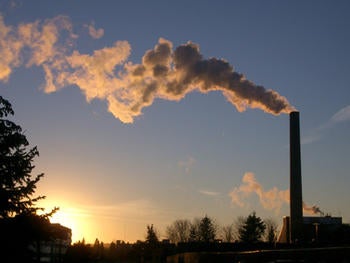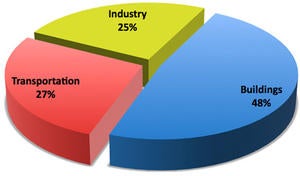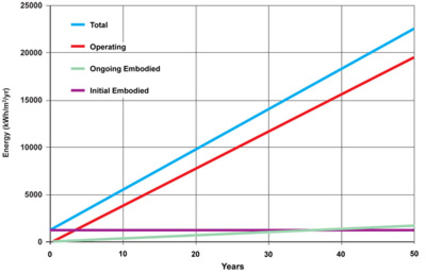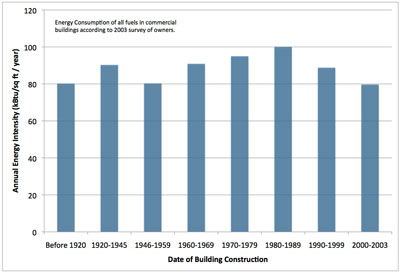The environmental crisis, and hence green building design, revolve around a wide range of issues: habitat destruction, stormwater run-off, air pollution, climate change, and resource use. However, the on-going consumption of energy to operate, condition, and light a building, as well as the energy embodied in on-going maintenance is the largest single source of environmental damage and resource consumption due to buildings. Energy security and carbon emissions have signaled an even stronger focus on energy in green buildings, particularly as the energy consumption growth rate of countries such as China, Russia, India and Brazil increase.

Photograph 1: Energy Matters—Building owners and designers will be increasingly concerned with energy use, energy efficiency, the choice of energy source, the distance of that source from their building, and the global impact of their building and operations.
Reducing the operational energy use and increasing durability should be the prime concerns of architects who wish to design and build “green” buildings. I have reached this conclusion after spending years looking at actual building energy consumption, reviewing countless computer simulations, and being involved in numerous green building charrettes. It has even been suggested (Lstiburek, 2008) that 80% of a green architect's concern should be directed towards reducing energy consumption during operation.

Figure 1: US Building Energy Use (from architecture2030.org)
Scientific life-cycle energy analyses have repeatedly found that the energy used in the operation and maintenance of buildings dwarf the so-called “embodied” energy of the materials. Cole and Kernan (1996) and Reepe and Blanchard (1998) for example found that the energy of operation was between 83 to 94% of the 50-year life cycle energy use (Figure 2).

Figure 2: Embodied energy is swamped by operational energy in almost all building types (based on Cole & Kernan, Bldg & Environ, 1996)
Despite the massive amount of evidence pointing to the importance of energy consumption to green design, designers and even rating programs like LEED still seem fixated on material choices, not energy reduction. Perhaps the lack of attention to this critical issue is a result of the fact that architects are trained in the arrangement of spaces, massing, cultural influences, and the selection of finishes. Designing buildings that consume little operational energy is not a normal skillset: it requires much more quantitative understanding of heat transfer and radiation physics, weather and sun, and mechanical equipment operational details than architects normally possess. Nevertheless, it is the architect that makes most of the significant choices that impact energy consumption.
The trend in the last decades has not been encouraging. According to the Department of Energy’s Commercial 2003 Building Energy Consumption Survey, the energy consumption is not less than buildings built before 2003 (Figure 3). A New Buildings Institute study has shown that LEED buildings use essentially the same amount of energy. The real savings from improved window technology, more efficient equipment, and better design tools have disguised the fact that we are wasting more energy because of over-ventilated, over-glazed, and under-insulated buildings.

Figure 3: Actual Measured Energy Consumption versus Year Constructed for US Commercial Buildings (data from DOE Energy Information Agency CBECS 2003 Survey)
If a building’s orientation, massing, window area/shading, insulation arrangement, and airtightness are not properly optimized, no amount of mechanical engineering, heat pumps, chilled slabs, natural ventilation or green materials can make the building a “low-energy” building. And if it is not a low-energy building, it is not a green building.
Complex underfloor air systems, double-facades, green roofs, and heat pumps are all technology with potential, but will not save energy if the architect’s design (let alone the mechanical engineer’s) is not appropriate. In many cases these technologies are added to a poor building, and the result is average energy consumption despite the use of good, or even exceptional, mechanical design and equipment. Efficient and high-tech equipment and controls can moderate— but not make up for—bad building design.
The solution to this problem begins with awareness of the importance of operational energy consumption to environmental damage, resource depletion, habitat destruction, and hence, to green buildings. Solutions will take many forms, but all will involve prediction of energy consumption, and confirmation that the designed low-energy building is actually built and operated as one. Only then do we have proof it is a green building. The Architecture 20301 challenge is based entirely on this premise. The choice of a minimum 50% reduction in energy use per building floor area has the major advantages that it is economically achievable today, with today’s technology, skills and materials; is significant enough to make a real difference; and does not require any great precision (that is, one can be in error by 5% in design, operation, or measurement and the building remains a great success).
Energy consumption should be measured in terms of environmental damage, such as carbon emissions, resource depletion, or habitat destruction. None of these impacts are easily measured. However, every month a small army of people (meter readers) are deployed around the country to measure the energy used in buildings, and this energy use data is remarkably precise, condensed into easy-to-read formats, and mailed to building owners. Therefore, the most readily available and scientifically rigorous measure of energy is in units of Btu, megajoules, or kilowatt hours as provided in energy bills. One disadvantage to this approach is that all energy is not equal when it comes to environmental impact. In many places in North America, electrical energy delivered by the grid is more polluting, from a greenhouse gas perspective, than natural gas. However, there are simple correction factors available. Measuring energy in the form of dollars presumes that environmental damage is related to dollars. It is not, and this format should be avoided.
Meeting the challenge of delivering low-energy buildings will, however, require a different approach to design, the development of new skills, and a focus on new priorities. Checklists and rating programs (like LEED, BuildGreen, and GreenGlobes) are neither sufficient nor necessary, but could be complementary to the quantifiable end goal of low energy consumption.
Issues of recycled content, low embodied energy, and natural ventilation are not unimportant. However, if these concerns distract so much that a low-energy building does not result, then the environment is risked. LEED could take a true leadership role if Energy and Atmosphere credits were weighted far more heavily, or if the prerequisite reduction in energy intensity (based on real buildings) were raised to 30 or 50%.
The operational energy use of buildings is their biggest environmental impact. Green buildings, which must be low-energy buildings, need to be designed to respond to this reality.
Footnote:
Architecture 2030 a non-profit, non-partisan and independent organization, established in response to the global-warming crisis by architect Edward Mazria in 2002. Its mission is to rapidly transform the US and global Building Sector from the major contributor of greenhouse gas emissions to a central part of the solution to the global-warming crisis. Its goals have been adopted by hundreds of firms and organizations.
References
Cole, R., and Kernan, P. “Life-cycle Energy Use in Buildings”, Building & Environment, Vol. 31, No. 4, pp. 307-317, 1996.
Reppe, P, and Blanchard, S. Life Cycle Analysis of a Residential Home, Report 1998-5, Center for Sustainable Systems, University of Michigan, 1998.
